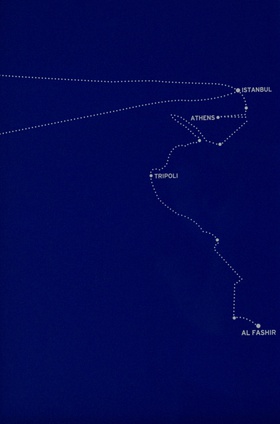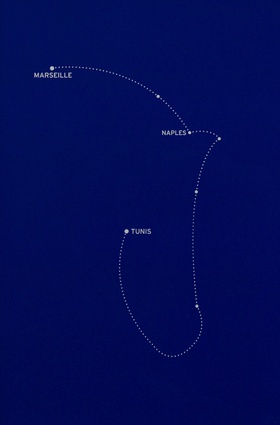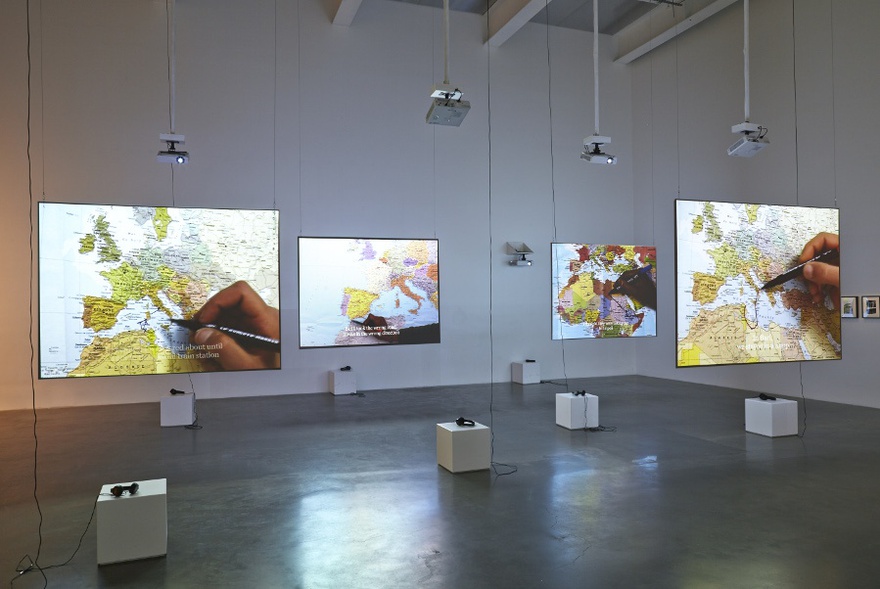Essays
Other Maps
On Bouchra Khalili’s Cartographies
In a 2010 text, Kaelen Wilson-Goldie made note of a preponderance of maps appearing in contemporary art particularly from the Middle East and North Africa. She argued that this trend may be a response to both market and geopolitical forces eager to neatly define regions, or that it is meant to propose a simplified illustration of what the Middle East looks like. She goes on to suggest, rhetorically perhaps, that it may be time to move forward without maps – using them neither as guides to hypothesize content nor as limits to constrain the understanding of work that emerges from the Middle East.[1] But before we throw out our maps, burdened as they are, is it possible to redraw and to rethink them? Can we find use in them as open metaphors and generative platforms that serve not to calcify an idea of a region, but rather help us to locate meaning within the contours of a broad world?
For Bouchra Khalili, the exercise of mapping is an expansive and varied intellectual undertaking that employs a multiplicity of methodologies to redraw the world and the stories within it. Khalili uses mapping to unhinge the possibility of any fixed ideas of regionalism or nationalism; of past as distinct from present, or of centre as discernible from periphery. In her work, mapping becomes the outgrowth of storytelling, and the vivid three-dimensionality of history guides her understanding of geography. The question of where one region lies in relation to another, literally and metaphorically, is revealed, interrogated, and complicated within her practice. Just as the central question posed in this platform, which asks how we considerthe relationships that exist between North Africa, the Middle East and the Global South, seems to point to our continued need if not for maps, then for mapping, and to the fact that we are still deeply engaged in questions of plotting a transnational framework in our art history courses and exhibitions.
Indeed, there remains a desire to see connections between, across, and against place; to discover a way in which to 'effectively map' broad temporalities and geographies. Something that is explored in one of Khalili's best-known works: an eight-channel video installation, The Mapping Journey Project (2008–11). This piece explicitly employs maps as its primary visual and structuring device. In each video we see an anonymous hand holding a pen and tracing his or her movement across international maps radiating out from the Mediterranean Sea, situated between Africa, Europe and the Middle East; in some, the camera is panned out as far as South Asia. The sound component for the videos is a spoken narrative of these movements, told in whatever language the participant chose (subtitled below). Each protagonist relates the story of their journeys from where they originated to far-flung locales, sometimes over the course of years. And while many stories are harrowing, rife with tragedy as well as the oppressive weight of bureaucracy and indeterminate periods of waiting, the speakers offer cool recollections that are deeply personal but emerge as factual accounts. Terrifying journeys at sea, time spent in jails and detention, betrayals, theft, illness, misdirection, lack of information, and deportation are contained within the stories and pressed into the imagination of the viewer.
Despite the complexities and harsh realities relayed, The Mapping Journey Project attempts to be neither sentimental nor didactic. Khalili's works are defined by a sparse visual quality, and the stark severity of her formal treatment and lean editing imbues her films with an unyielding sobriety. Each video within The Mapping Journey Project is limited to a single, fixed shot hovering above the map. Even in much more complicated recent projects, the artist relies on a limited number of fixed camera positions, a concise visual vocabulary, and a sharply refined aesthetic. In part, Khalili's directness is achieved through visual means that speaks to her abiding relationship to a history of cinema. The language that infuses her projects, often original to the speaker, is without exception precise and forceful, void of excess or manipulation. The interrelation between image and language and the power vested in the first person accounts within Khalili's work are tied to notions of free indirect speech, particularly as explored in the work of Pier Paolo Pasolini – a vital touchstone for the artist. In this, free indirect speech in which first- and third-person speech are reflexively conflated by a narrator, manifest both through language and filmic style. It is a methodology that gives precedence to the storytelling voice as constructing reality, and through which Khalili empowers her speakers.[2]
While literal maps are the central visual element of Mapping Journey Project, they are employed only to be subverted. The blue water and multi-coloured countries that abut one another become graphic abstractions as each protagonist draws lines across and through them. The borders between places are arguably the most important element to each character's story – their defining antagonist – but the borders are also, as each speaker's constant traversals imply, arbitrary, state-sponsored manmade obstructions. The inclusion within the eight videos of an altogether different and much smaller map of the area between Israel's western border and the Palestinian territories reveals the political dimensions of not only the work, but of the entire concept of movement and migration at the core of Khalili's practice. Seven of the maps show numerous countries residing on different continents, but the singular video, Mapping Journey #3, which shows the borders between these two contested places, is what critically illuminates the artist's guiding philosophical position: migration and travel are not simply tied to ideas of economic opportunity, exile, or escape. Rather, they also operate as modes of resistance: they are lived expressions of political positions that refuse state control and power, and the restrictions of nationalisms, regionalism, and ideology. The smaller map, often ignored by critics in assessments of this work, is the sharpest indication of the arbitrariness and implicit subjugation of borders.
The closely related project consisting of a series of eight silkscreen prints, The Constellations (2011), is a striking response to the influence of maps. In this work, the artist translated the movement of each protagonist in the eight videos into a print that plotted his or her journey against a blank blue background, creating 'constellations'. The points or stars in these works chart stops (both identified and unmarked) along routes, without national indications or borders. The work inverts the logic of navigating by way of stars, instead making the subject's journey the reality by which the map is created. Within The Mapping Journey Project, and to some degree The Constellations, a literal map is a vital structuring device, but the work emerges through storytelling not cartography: two modes that are in dialectical tension throughout Khalili's practice. This is underscored in the trilogy that followed The Mapping Journey Project, called The Speeches Series (2012–13), which exerts the force of language and subjective experience as the central theme of the works by taking transnational existences as a certainty and again giving precedence to minority experience.
The second chapter of The Speeches Series, which was produced for the 55th Venice Biennale, focuses on original manifestos delivered by people living in Genoa. They address issues of citizenship, nationality, belonging, and identity – returning us to the positions articulated in The Mapping Journey Project. While each of the five subjects featured in Speeches – Chapter 2: Words on Streets (2013), currently live in Italy, some are immigrants, and some are the children of immigrants. All reveal the complexity of their minority position within their adopted country, expressing fear, resentment, and loneliness, alongside a political consciousness that demands a place of dignity and respect within the world. The displacement and discrimination that haunt these individual speeches are subsumed to the larger political positions they espouse. Each vignette is deeply subjective, but illuminates, as the artist says 'a collective voice'.
Significantly, each participant delivers his or her speech in (empty) public spaces, each recitation seemingly an attempt at creating public discourse. The choice of setting is a homage to and realization of Pasolini's 'civil poetry' – which the artist explains as, 'the right taken by a citizen to address the social body, through language and words'.[3] Khalili sites her work within this tradition and in doing so emerges from a long intellectual history that posits the artist's responsibility as one of enacting civic discourse and political consciousness as a poetic gesture within the public sphere. The subsequent screening of this piece within the spaces of art institutions and public exhibitions is an echoing continuation of this mode of address.
The coda to The Speeches Series, Speeches – Chapter 3: Living Labour (2013), focuses on five immigrants from Mali and Mexico living in New York and their relationship to labour, place, immigration status, and economy.Khalili employs a similar format to the previous two chapters in the series, but returns the speaker to more intimate, private settings – a reflection of their clandestine existences within the urban environment. While each relates tales of migration and work, they reveal their cosmopolitan relation to the broader world. Their frank discussion of capitalism, workers rights, and their own position and experiences, as in The Mapping Journey Project, places the point of reference within the hands of the individual. Among the many critiques this work delivers, it in part deconstructs notions of centre and periphery. Living Labour, and the entire Speeches Series, interrogates and reveals the way in which a perceived centre is indistinguishable from and comprised of 'periphery', whether through people, consciousness, or politics, whether acknowledged or not. In Khalili's work, the movement and experiences of these participants implicitly suggests the existence of counter hegemonic networks both subsist on and refuse the periphery.
Khalili's most recent project, Garden Conversation (2014), which was presented as part of the Abraaj Capital Art Prize at Art Dubai in 2014, involves a mode of retracing and reimagining. It excavates a subsumed radical past through the careful and exacting interpretation of a precise moment of twentieth century history. This project asserts the legacy of anti-colonial revolution, particularly within the Middle East, and attempts to narrate a context and continuity for current events. The work can also be read as a form of (re)mapping – illuminating a transnational history that connects places and people through routes of shared political consciousness and resistance.
The opening text of the video establishes the premise for the work:
In January 1959 at the Embassy of Morocco in Cairo, Ernesto Guevara met Abdelkrim Al Khattabi[,] the old and exiled Moroccan hero of the Rif War (1921–1926)[,] who fought the Spanish and French Occupation and founded the short-lived Rif Republic. Guevara and Al Khattabi spent several hours talking in the Embassy gardens. No traces remained of the meeting except a few testimonies.
In this project, Khalili imagines this meeting with a deep sensitivity to the contemporary moment. The work uses a number of modes – chief among them site and language – to articulate its concerns. In five short chapters, the two 'men' discuss a range of topics. Their dialogue is derived from their own writings, meticulously mined and woven together by the artist.[4]
The video was shot on location in Melilla, a small Spanish territory on the north coast of Morocco. This contested site, a living artefact of colonialism, is both unique and in many ways exemplary of the strange territories that arise along borders. Its specificity is revealed quietly at the beginning of the film. But, pictured in the artist's signature long, blinking takes, the charge of the landscape is evident – its windswept forest, the fences that hem in this small piece of Europe on African soil, the blocked passages to and from the sea (the short distance that divides Africa from Europe) – resound with the potent subtext of geography and place that defines the artist's practice.
The figures in the work take on the roles of Che and Al Khattabi, and speak two different dialects – harkening back to Speeches Series – Chapter 1: Mother Tongue (2012) and Khalili's persistent interest in articulation and communication. Al Khattabi speaks Moroccan Arabic, whereas Che speaks Iraqi Arabic. This dimension of the work is lost on the non-Arabic speaker (who receives the work through subtitles; I include myself here), but is hinted at in the static appearance of the two characters who often appear to be speaking across, rather than to, one another. Their stilted interaction also reflects their status not as characters being acted out, meant to believably be these figures, but rather extends the transposition suggested by the youth, gender, and the origins of the protagonists. They are not actors, but something more akin to avatars. Their recitation of Che and Al Khattabi is an invocation of what the artist describes as the way history haunts the contemporary moment, and only adds to the temporal displacement of the piece.[5]
The words recited in Garden Conversation have a profound relevance and resonance presented now, more than 50 years after they were first expressed: it is jarring to remind oneself that a half century stands between the viewer and the sentiments being communicated. In this, Khalili's goal was not to give us a glimpse into history, but to allow history to enter the present. Che and Al Khattabi, two revolutionary leaders separated by a generation and an ocean, were connected – and though the exact content of Khalili's conversation is fabricated, it is grounded firmly within a historical event. A meeting in 1959 – a moment that has been overtaken by larger narratives, and but one crucial example of a 'global' history that finds links between faraway places. In Garden Conversation, Khalili's use of this episode reinforces the underlying logic of her practice, which finds deep roots in a historic notion of third-world solidarity and reconnects this history's meaning and significance to the contemporary moment as neither philosophical nor theoretical, but as lived reality.
While Khalili's projects take on various ideas and forms, a central theme in her work is the struggle against oppression and the possibility of solidarity. Her earlier pieces echo this through their examination of contemporary political consciousness, but in Garden Conversation, this is made explicit, foregrounding the artist's interest in the global iteration of radical politics. The transnational solidarity that emerged throughout the twentieth century in tandem with nationalist and ant-colonialist movements unquestionably demonstrate the inextricable, but often obscured, relationship between geographically removed places. This is not the purpose of Khalili's work; it is not grounded in geography and maps, and certainly not within the contours of regional distinctions. Khalili's point of reference is the inarguable reality of histories, politics, and culture: a form of counter mapping that moves against hegemonic constructions of borders and place, narrating connections and plotting courses that we would be wise to follow.
[1] Kaelen Wilson-Goldie, 'Off the Map: Contemporary Art in the Middle East,' in The Future of Tradition – The Tradition of Future, eds. Chris Dercon, León Krempel, and Avinoam Shalem (Munich: Prestel Publishing, 2010), pp. 60-67. Rpt. In Here and Elsewhere, eds. Negar Azimi, Natalie Bell, Gary Carrion-Murayari, Massimiliano Gioni, and Kaelen Wilson-Goldie (New York: New Museum, 2014), pp. 205-212.
[2] I am grateful to the artist for her discussions of free indirect speech and for pointing me to this helpful elaboration of this idea during our autumn 2013 discussions: David Heinemann, 'The Creative Voice: Free Indirect Speech in the Cinema of Rohmer and Bresson,' The New Soundtrack 2.1 (March 2012): 39-49.
[3] Bouchra Khalili, e-mail message to author, 13 November 2013.
[4] At the end of the work, Khalili includes a bibliography of the texts she used to construct the work. While the artist always cites the texts with which she is working, the use of a bibliography in this instance is less about references, and more a means to establish a historiography, an exploration of the making of history as both 'a construction and a narrative.' Bouchra Khalili, email message to the author, 26 October 2014.
[5] Their mode of speaking also echoes the methodology explored through the idea of the indirect speech act in the work of Robert Bresson. As Heinemann describes it, Bresson instructed his actors to deliver their lines as if giving a monologue, making them appear divorced from their context. This serves to 'de-dramatize' their speech and to give a 'textual quality to speech' – something we feel implicitly in Khalili's project. See op cit., Heinmann, 'The Creative Voice'.








